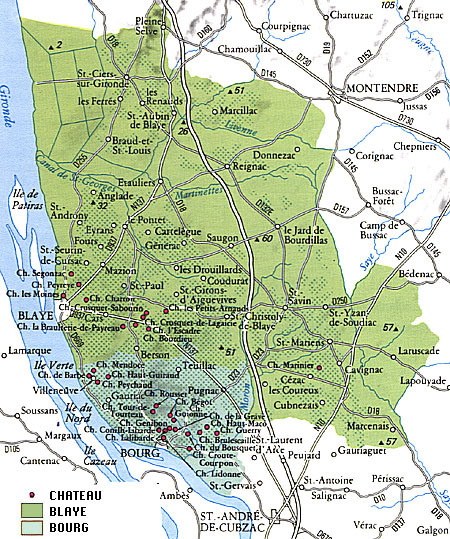
WineRegionsOld WorldFranceBordeaux
Bourg and Blaye
Ninety-five per cent of the wine produced here is good-value red. Tiny Bourg
makes more wine than its five-times-larger neighbor, Blaye, and most
of the vines grown in Blaye come from a cluster of chateaux close to the
borders of Bourg. As one would expect of an area that has supported a settlement
for 400,000 years, Bourg has a close-knit community. Comparatively recently,
the Romans used neighboring Blaye as a castrum a fortified area in the defense
system that shielded Bordeaux. According to some sources, the vine was cultivated
in Bourg and Blaye as soon as the Romans arrived. Vineyards were certainly
flourishing here long before those of the Medoc just the other side of the
Gironde.
Bourg is a compact, heavily cultivated area with pretty hillside
vineyards at every turn. The vine is less important in Blaye, which has
other interests, including a caviar industry based at its ancient fishing
port where sturgeon is still a major catch. The vineyards of Blaye are mostly
clustered in the countryside immediately bordering Bourg, and, despite the
similarity of the countryside, traditionally produce the slightly inferior
wine. The D18 appears to be a barrier beyond which the less intensely cultivated
hinterland takes On a totally different topography where the more expansive
scenery is dotted with lonely forests.
To the Romans, these south facing vineyards overlooking the Gironde seemed
the ideal place to plant vines. Because they failed, understandably, to
realize the possibilities that the Medoc concealed beyond its virtually
impenetrable marshes, it does not necessarily follow that they were wrong
about Bourg and Blaye. Indeed, the quality achieved today in these vineyards
would have surpassed the most optimistic hopes of those past masters of
the vine. Since their time, new and different concepts of classic wine have
relegated this district to a viticultural backwater, but its potential remains
the same. In twenty years time, when we have at last discovered Fronsac
and elevated Canon-Fronsac to a level equivalent to that of Pomerol. These
proprietors have great potential of these wines if a lure for higher prices,
entices these growers to restrict yields, improve vinification techniques
and indulge in a percentage of new oak.
